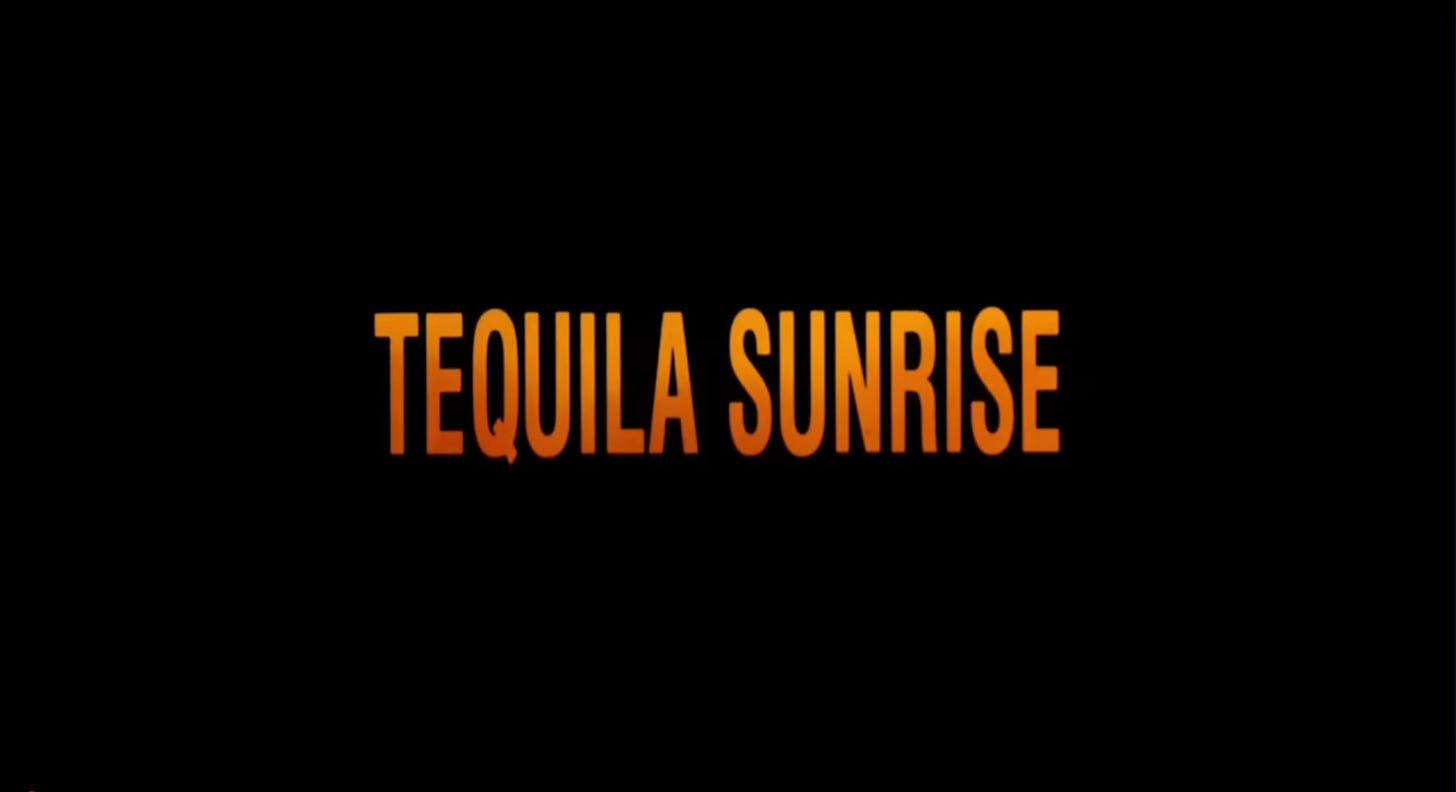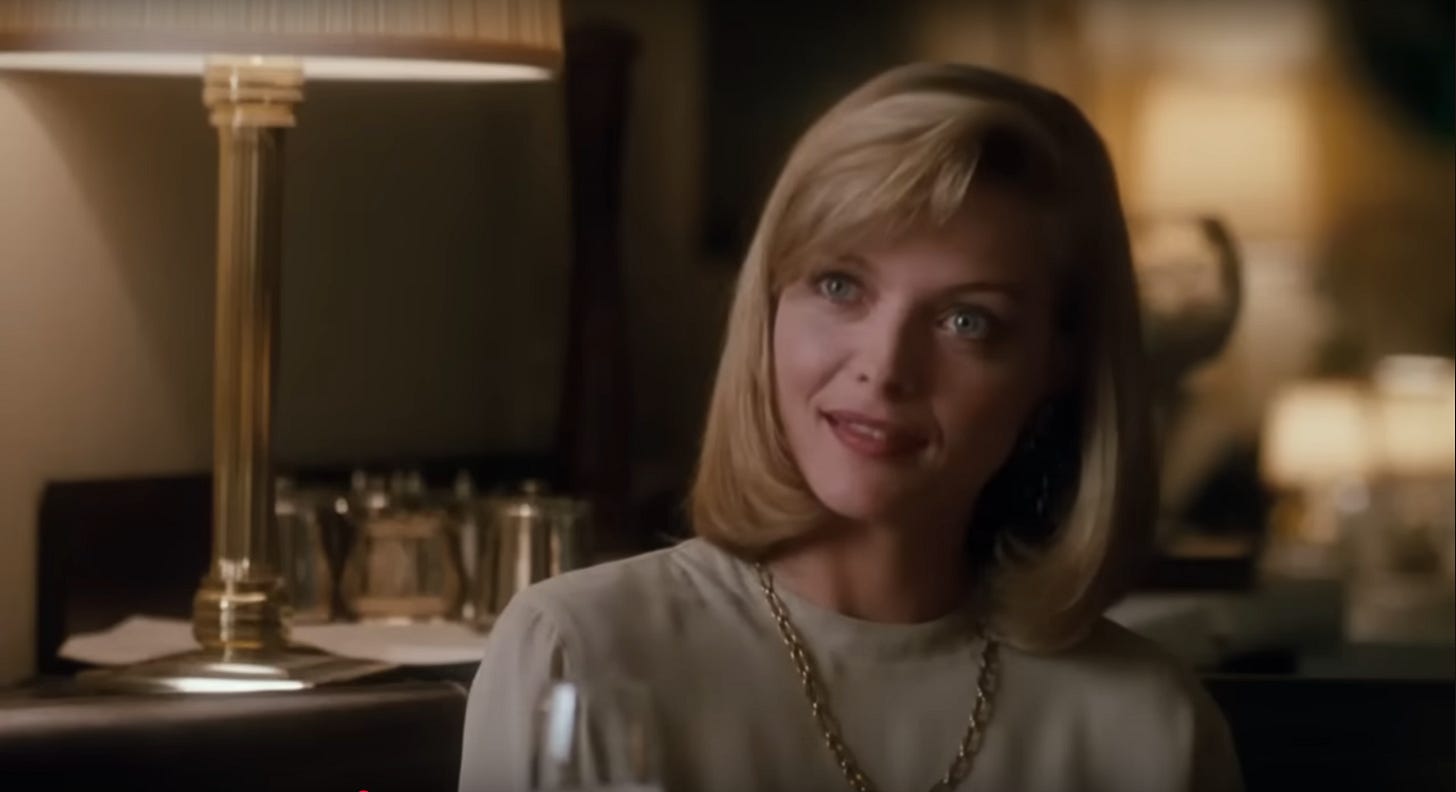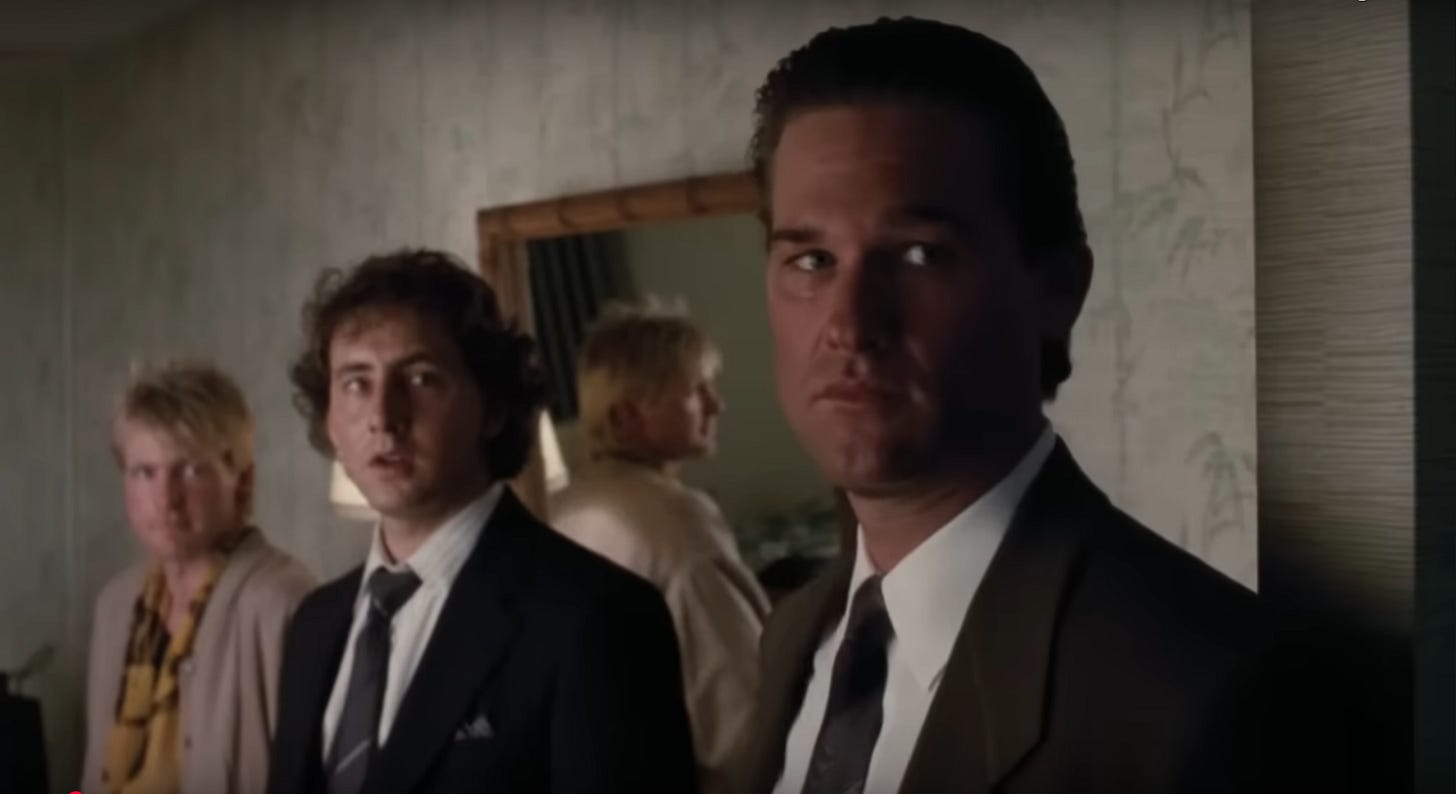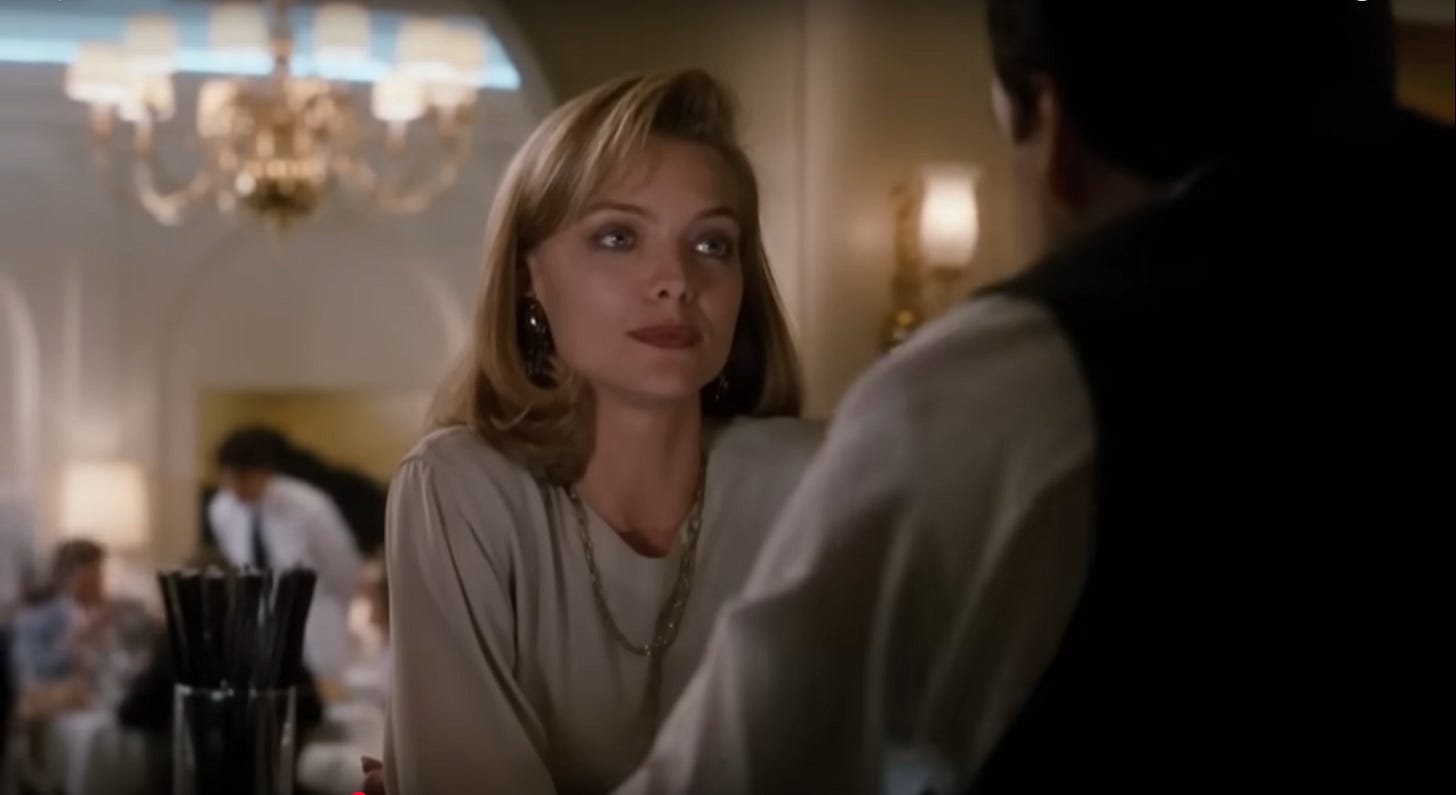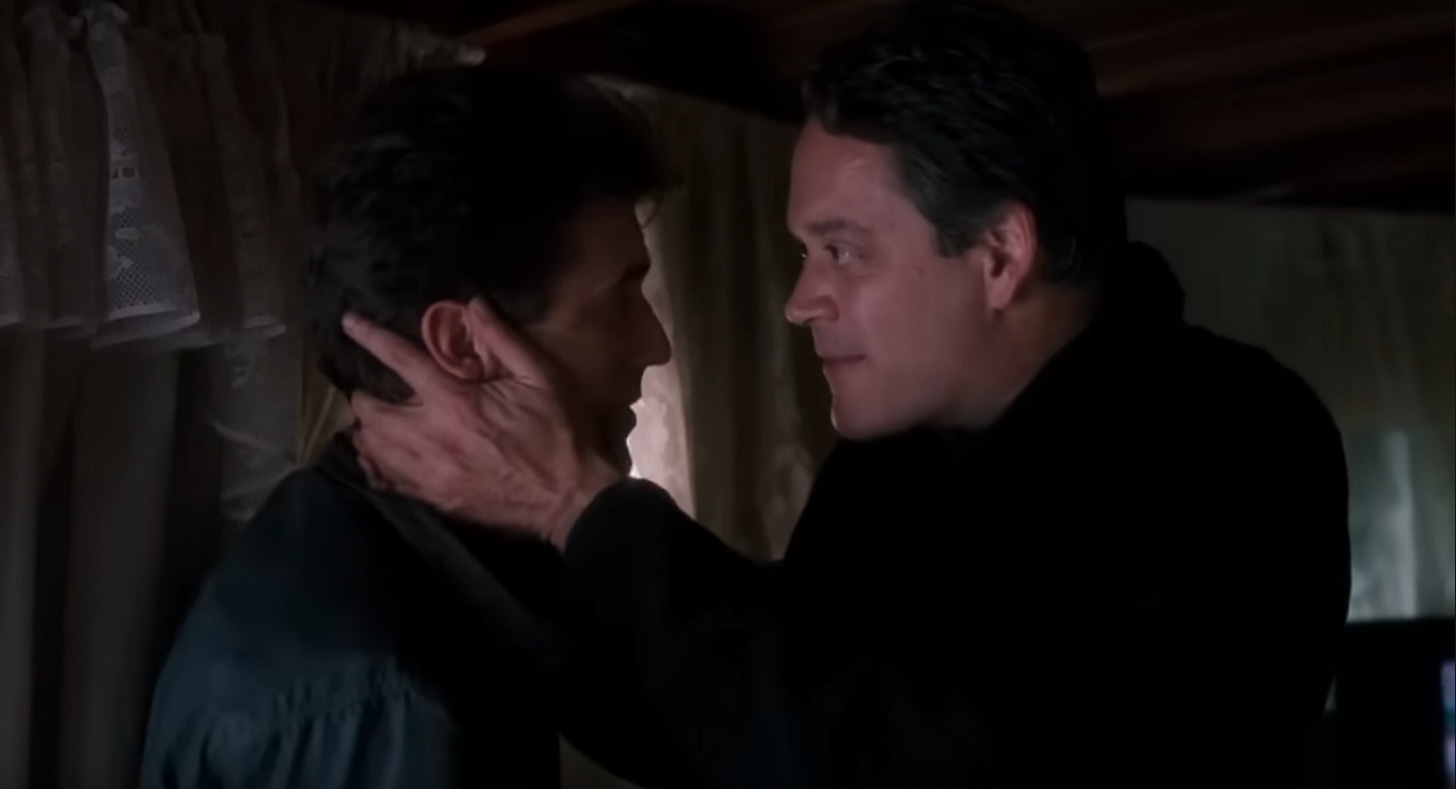Video Days is Mad About Michelle in the month of April, with ten films starring leading lady Michelle Pfeiffer, born April 29, 1958 in Santa Ana, California and celebrating her 67th birthday this month.
TEQUILA SUNRISE (1988) is a romantic melodrama about how friendships are tested when business gets in the way. The filmmaking pontificates on this theme without introducing anything tangible for viewers to get excited about. The movie boasts three of its era’s biggest stars–Mel Gibson, Michelle Pfeiffer, Kurt Russell–and was written and directed by Robert Towne, author of Chinatown (1974), getting a mulligan here after his directorial debut was beset by production woes. It should’ve been a layup, if anyone had bothered to put air in the ball.
Robert Towne was born and raised in Los Angeles. His father owned a women’s clothing store but even during the Great Depression, had an eye on upward mobility, moving the family from San Pedro when Towne was a boy to the Palos Verdes neighborhood of Rolling Hills, and changing their names from Schwartz to Towne. Robert was enrolled in private school and attended Pomona College, studying English and philosophy. Conscripted by the U.S. Army for his mandatory two year service following college, Towne returned to Southern California without a great deal of direction. He accompanied a girlfriend to an informal acting and improv class in Malibu instructed by Jeff Corey, who’d prospered as a character actor in the Hollywood studio system of the 1940s before an actor named him to the House Un-American Activities Committee and as a result, was blacklisted from screen work (Corey would not only return to films, like Butch Cassidy and the Sundance Kid in which he played a sympathetic sheriff, but counted James Dean, Rita Moreno, Jane Fonda, Cher and others as students).
Towne had never taken a screenwriting course, “writing” at that time existing as a vocation of novelists, playwrights or poets, but credited Corey’s class for teaching him he wasn’t an actor and over seven years, how to write for film. Towne met a classmate named Jack Nicholson he was convinced was going to be a successful actor, and pledged to write for him. Another student in Corey’s class was Roger Corman, a writer/ producer of low budget exploitation films. Corman began roping Towne and Nicholson into his productions, Towne writing Last Woman on Earth (1960), in which the title character survives an apocalypse to be caught between her husband and his friend (played by Towne). Of the scripts Towne cranked out for Corman was a bid for studio prestige, a Civil War action/ adventure titled A Time For Killing produced by Columbia Pictures, but Corman dropped out as director and Towne removed his name from the picture.
Warren Beatty was a fan of Towne’s script and commissioned him to do some work on Bonnie and Clyde (1967). This led Towne to several more uncredited assignments, triaging big problems on real films: Drive, He Said (1971) for writer/ director Jack Nicholson and The Godfather (1972). Towne received his first Academy Award nomination adapting the novel The Last Detail (1973) as a starring vehicle for Nicholson, and with help on the front-end from his friend Edward Taylor and on the back-end by director Roman Polanski, authored what many consider the greatest screenplay ever written, Chinatown (1974), a detective story set in 1930s Los Angeles that juxtaposed a rape of the natural world with the rape of a young woman, those in power trying to cover them both up. In 1981, he completed an early version of a screenplay titled Tequila Sunrise. Its story focused on handsome and aloof drug smuggler named Dale McKussic who tries to compel the beguiling hostess at his favorite seafood restaurant, as well as a childhood friend who is now a lieutenant in the L.A. County Sheriff’s Department, that he’s no longer running dope. Warren Beatty, the handsome and aloof star Towne had co-written Shampoo (1975) with, was mentioned to possibly star.
Toward the end of his marriage to his longtime partner Julie Payne, Towne had become a regular at Valentino, an Italian restaurant in Santa Monica, whose co-owner Luisa Selvaggio would leave her restaurateur husband to marry Towne. He continued to work on the script in 1982, gaining experience with friendships going sideways over business. He filed a lawsuit accusing Warner Bros. and producer David Geffen of fraud, coercion, defamation and breach of contract surrounding Personal Best (1982), Towne’s debut as a writer/ director, seeking $110 million in damages. The row was settled a year later when Bob Daly took over as studio chairman and offered to call off the lawyers if Towne did. As part of the settlement, Warner Bros. secured the right of first refusal on Tequila Sunrise whenever Towne finished it. In the spring of 1987, he was in Paris working on a production rewrite of Frantic (1988) for Roman Polanski and showed a new version of Tequila Sunrise to Thom Mount, who agreed to come aboard as producer, with Towne directing, the Mount Company co-financing a production budget of $23 million with Cinema City Films, and Warner Bros. providing distribution.
Mount and Towne agreed Harrison Ford could play the retired drug smuggler, Ford at that time balancing classical heroes in pictures like Witness (1985) with those whose leading men were less virtuous, like The Mosquito Coast (1986). Dale McKussic would’ve qualified as both, but Ford demurred and Towne flew to Sydney to reel Mel Gibson in for the lead. With Michelle Pfeiffer, Kurt Russell, J.T. Walsh, Arliss Howard, Arye Gross and Raul Julia filling out a cast, shooting commenced in February 1988. Ten days into production, director of photography Jost Vacano, the German cinematographer of Das Boat (1981), was dismissed, dailies looking grittier than Towne anticipated. Conrad Hall, the master of light who’d lit In Cold Blood (1967) and Cool Hand Luke (1967), came aboard and would be nominated for an Academy Award for his more romantic work. The filmmakers were racing to head off a looming strike by the Writers Guild of America, but got rolling as much as a month behind schedule. The WGA did initiate a work stoppage on March 7 that would stretch to August 7, Towne’s union barring him from generating any written material during that time.
Filming locations included the South Bay neighborhoods where Towne had spent his early childhood: San Pedro, Redondo Beach, Hermosa Beach. Interiors for McKussic’s home on the Manhattan Beach Strand were filmed on a set constructed inside a warehouse in Santa Monica, as was another major set, interiors for “Vallenari’s Restaurant.” Tequila Sunrise opened in December 1988 in 1,115 theaters in the U.S. Reviews leaned negative. Gene Siskel and Roger Ebert split. Siskel found the first two-thirds of the picture fascinating, with good performances in a story he was pleased not to have figured out, the ambiguity becoming too much for him in the final third, though he recommended the film. Ebert turned thumbs down, crediting the acting of its three leads in a movie that didn’t hold together. It spent six holiday weekends among the country’s top ten grossing films, the comedies Scrooged, The Naked Gun, Twins and Dirty Rotten Scoundrels filling in more seats, three of them without costing as much. Tequila Sunrise has its admirers among neo-noir fans, but largely remains a hidden movie.
Like many of the movies deprived of script revisions due to the WGA strike–including Twins and Rain Man--Tequila Sunrise tries to patch over holes in its story with the charisma of its stars and the narrative finesse of its director to create on the fly. The cast was up for the challenge. Mel Gibson chose this as his follow-up to his first box office smash made in America, Lethal Weapon (1987), Michelle Pfeiffer came aboard after her ensemble work in The Witches of Eastwick (1987), and Kurt Russell in the wake of another picture for the actor that was ignored in theaters but found its fanbase on videocassette, Overboard (1987). With a cast as glamorous and potent as any of Hollywood’s Golden Age, with Raul Julia worthy of inclusion there as well, Tequila Sunrise plays like a cops and robbers thriller where the thrills have been torn out and instead of doing anything, characters poke at each other to reveal secrets, with no way of knowing whether what they’re being told is true and no way for the viewer to know either.
Scenes aren’t missing so much as Tequila Sunrise lacks scenes. The backstory for Gibson’s character is that he’s returning after serving two years in a Mexican prison, but we’re deprived of moments where we watch him readjust to civilian life or process his trauma, which would’ve made it possible to relate to him. He doesn’t even speak Spanish. Pfeiffer’s role is thankless, a hostess who two men corner at work and by virtue of her beauty, fight over. Russell’s character badgers Gibson over whether he’s out of the drug business, which demonstrates what a lousy detective he is, clueless as to whether even his childhood friend is dealing. The exciting version of this character would be on the street and wouldn’t have to bother Gibson with anything other than an arrest warrant or invitation to go surfing. The film’s energy levels up when Julia, playing a Mexican federale, makes his entrance, belting opera and giving the picture a desperately needed creative spark. The film Towne had in mind might have been one that mirrored his dining experience of watching business deals being made, alluring women working, and relationships falling through, but Tequila Sunrise doesn’t dramatize much of that. It doesn’t even look good, fumbling opportunities for neo-noir to settle for what often looks like a Red Lobster commercial, without the food.
Video rental category: Mystery/ Suspense
Special interest: Surveillance Society



